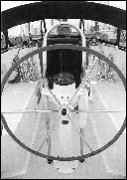You donít have to ask the question "Want to go sailing?" twice to anyone
on the SAILING Magazine staff. The occasion was the Caliber 40LRC Boat
Test on the Lake Michigan waters only a stoneís throw from the office
doorstep. The office cleared out in minutes on a fine fall afternoon
complete with a 15-knot southerly blowing across the lake, still warm
from the summer sun.
The Caliber 40LRC was
easy to spot as we headed out the dock to one of the few remaining
sticks left in the marina. There is no mistaking this boat for a coastal
cruiser or a lightweight racer. Its beefy bowsprit and cutter rig give
it the stamp of a seaworthy offshore cruiser.
Caliber Yachts of
Clearwater, Florida, is run by the McCreary brothers. George runs the
business side of the operation, while his naval architect brother Mike
is the designer of the entire line of Calibers. Placing great emphasis
on solid construction and offshore design, Caliber has steadily grown
since 1980. The latest development is the Long Range Cruiser line,
including the Caliber 40LRC.
As we piled aboard and
set about making ready to sail, I took a look around the
well-thought-out deck layout. The overall
effect is a clean modern look. There is just a hint of teak on the coach
roof, bowsprit and cockpit, enough to add a bit of style, but not enough
to make teak maintenance an endless chore.
The Caliber 40 is set up
for short-handed sailing, with all sail control lines lead aft to Lewmar
winches and rope clutches. All winches are self-tailing and there is
Harken roller furling for the genoa. Roller furling is an option for
the staysail, which is flown from a removable inner forestay.
The 40 we tested had the Dutchman mainsail handling system to make
furling after sailing easy, but in-the-mast roller furling is also
available on the Z-Spar mast.
Ted Meljac of Great Lakes
Marine Service, the Caliber dealer in Grafton, Wisconsin, handed us the
keys, and we slipped the lines and headed out. The Caliber 40 handles
comfortably under power, driven by a 50-horse-power Yanmar 4JH-2BE, but
like most cruising boats, it needs a sure hand while backing to avoid
stalling the rudder.
As we headed out the gap,
the southerly filled the sails. We had everything flying as we took off
on a reach at more than 7 knots. The cutter rig allows for a variety of
sail plan options. The self-tacking staysail is rigged to a track before
the mast and makes tacking as easy as a sloop.
As we hardened up, we
realized we had a bit more canvas than was prudent, but the Caliber 40
shouldered it well. It laid over and the helm became somewhat stiff, but
the boat tracked well to weather. Reducing sail was so simple it
surprised the racing contingent on board. With a simple pull of the
roller-furling strings, the Caliber 40 stood back up and sailed on at
about 7 knots. Though it was more comfortable with reduced sail, the
boat felt steady and in control even when overcanvassed.